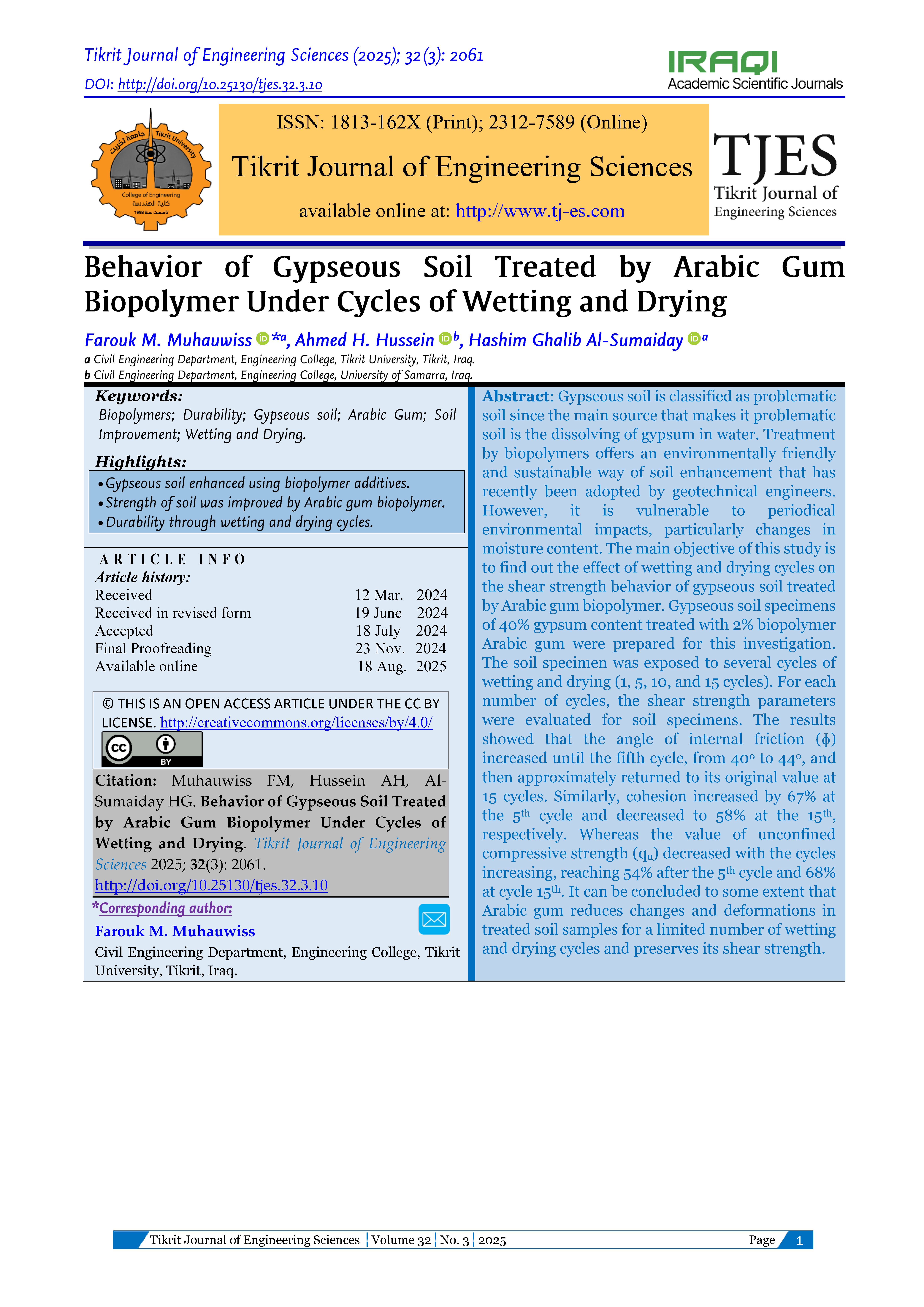Behavior of Gypseous Soil Treated by Arabic Gum Biopolymer Under Cycles of Wetting and Drying
محتوى المقالة الرئيسي
الملخص
Gypseous soil is classified as problematic soil since the main source that makes it problematic soil is the dissolving of gypsum in water. Treatment by biopolymers offers an environmentally friendly and sustainable way of soil enhancement that has recently been adopted by geotechnical engineers. However, it is vulnerable to periodical environmental impacts, particularly changes in moisture content. The main objective of this study is to find out the effect of wetting and drying cycles on the shear strength behavior of gypseous soil treated by Arabic gum biopolymer. Gypseous soil specimens of 40% gypsum content treated with 2% biopolymer Arabic gum were prepared for this investigation. The soil specimen was exposed to several cycles of wetting and drying (1, 5, 10, and 15 cycles). For each number of cycles, the shear strength parameters were evaluated for soil specimens. The results showed that the angle of internal friction (ɸ) increased until the fifth cycle, from 40o to 44o, and then approximately returned to its original value at 15 cycles. Similarly, cohesion increased by 67% at the 5th cycle and decreased to 58% at the 15th, respectively. Whereas the value of unconfined compressive strength (qu) decreased with the cycles increasing, reaching 54% after the 5th cycle and 68% at cycle 15th. It can be concluded to some extent that Arabic gum reduces changes and deformations in treated soil samples for a limited number of wetting and drying cycles and preserves its shear strength.
المقاييس
تفاصيل المقالة

هذا العمل مرخص بموجب Creative Commons Attribution 4.0 International License.
THIS IS AN OPEN ACCESS ARTICLE UNDER THE CC BY LICENSE http://creativecommons.org/licenses/by/4.0/
##plugins.generic.plaudit.displayName##
المراجع
Chang I, Im J, Cho GC. Introduction of Microbial Biopolymers in Soil Treatment for Future Environmentally-Friendly and Sustainable Geotechnical Engineering. Sustainability 2016; 8(3): 251. DOI: https://doi.org/10.3390/su8030251
Ayeldeen MK, Negm AM, El Sawwaf MA. Evaluating the Physical Characteristics of Biopolymer/Soil Mixtures. Arabian Journal of Geosciences 2016; 9(5): 371. DOI: https://doi.org/10.1007/s12517-016-2366-1
Nugent RA, Zhang G, Gambrell RP. Effect of Exopolymers on the Liquid Limit of Clays and Its Engineering Implications. Transportation Research Record: Journal of the Transportation Research Board 2009; 2101(1):34-43. DOI: https://doi.org/10.3141/2101-05
DeJong JT, Fritzges MB, Nüsslein K. Microbially Induced Cementation to Control Sand Response to Undrained Shear. Journal of Geotechnical and Geoenvironmental Engineering 2006; 132(11):1381-1392. DOI: https://doi.org/10.1061/(ASCE)1090-0241(2006)132:11(1381)
DeJong JT, Mortensen BM, Martinez BC, Nelson DC. Bio-Mediated Soil Improvement. Ecological Engineering 2010; 36(2):197-210. DOI: https://doi.org/10.1016/j.ecoleng.2008.12.029
van Paassen LA, Ghose R, van der Linden TJM, van der Star WRL, van Loosdrecht MCM. Quantifying Biomediated Ground Improvement by Ureolysis: Large-Scale Biogrout Experiment. Journal of Geotechnical and Geoenvironmental Engineering 2010; 136(12):1721-1728. DOI: https://doi.org/10.1061/(ASCE)GT.1943-5606.0000382
Whiffin VS, van Paassen LA, Harkes MP. Microbial Carbonate Precipitation as a Soil Improvement Technique. Geomicrobiology Journal 2007; 24(5):417-423. DOI: https://doi.org/10.1080/01490450701436505
Chang I, Cho GC. Strengthening of Korean Residual Soil with β-1,3/1,6-Glucan Biopolymer. Construction and Building Materials 2012; 30:30-35. DOI: https://doi.org/10.1016/j.conbuildmat.2011.11.030
Chang I, Prasidhi AK, Im J, Cho GC. Soil Strengthening Using Thermo-Gelation Biopolymers. Construction and Building Materials 2015; 77:430-438. DOI: https://doi.org/10.1016/j.conbuildmat.2014.12.116
Ferruzzi GG, Pan N, Casey WH. Mechanical Properties of Gellan and Polyacrylamide Gels with Implications for Soil Stabilization. Soil Science 2000; 165(10):778-792. DOI: https://doi.org/10.1097/00010694-200010000-00003
Ringelberg DB, Cole DM, Foley KL, Ruidaz-Santiago CM, Reynolds CM. Compressive Strength of Soils Amended with a Bacterial Succinoglycan: Effects of Soluble Salts and Organic Matter. Canadian Geotechnical Journal 2014; 51(7):747-757. DOI: https://doi.org/10.1139/cgj-2012-0369
Chang I, Im J, Prasidhi AK, Cho GC. Effects of Xanthan Gum Biopolymer on Soil Strengthening. Construction and Building Materials 2015; 74:65-72. DOI: https://doi.org/10.1016/j.conbuildmat.2014.10.026
Chang I, Im J, Cho GC. Geotechnical Engineering Behaviors of Gellan Gum Biopolymer Treated Sand. Canadian Geotechnical Journal 2016; 53(10):1658-1670. DOI: https://doi.org/10.1139/cgj-2015-0475
Seo S, Lee M, Im J, Kwon YM, Chung MK, Cho GC, Chang I. Site Application of Biopolymer-Based Soil Treatment (BPST) for Slope Surface Protection: In-Situ Wet-Spraying Method and Strengthening Effect Verification. Construction and Building Materials 2021; 307:124983. DOI: https://doi.org/10.1016/j.conbuildmat.2021.124983
Ko D, Kang J. Experimental Studies on the Stability Assessment of a Levee Using Reinforced Soil Based on a Biopolymer. Water 2018; 10(8):1059. DOI: https://doi.org/10.3390/w10081059
Khoury NN, Zaman MM. Environmental Effects on Durability of Aggregates Stabilized with Cementitious Materials. Journal of Materials in Civil Engineering 2007; 19(1):41-48. DOI: https://doi.org/10.1061/(ASCE)0899-1561(2007)19:1(41)
Kim J, Jeong S, Regueiro RA. Instability of Partially Saturated Soil Slopes Due to Alteration of Rainfall Pattern. Engineering Geology 2012; 147-148:28-36. DOI: https://doi.org/10.1016/j.enggeo.2012.07.005
Chang I, Im J, Lee SW, Cho GC. Strength Durability of Gellan Gum Biopolymer-Treated Korean Sand with Cyclic Wetting and Drying. Construction and Building Materials 2017; 143:210-221. DOI: https://doi.org/10.1016/j.conbuildmat.2017.02.061
Chen C, Wu L, Harbottle M. Exploring the Effect of Biopolymers in Near-Surface Soils Using Xanthan Gum-Modified Sand under Shear. Canadian Geotechnical Journal 2020; 57(8):1109-1118. DOI: https://doi.org/10.1139/cgj-2019-0284
Lemboye K, Almajed A, Alnuaim A, Arab M, Alshibli K. Improving Sand Wind Erosion Resistance Using Renewable Agriculturally Derived Biopolymers. Aeolian Research 2021; 49:100663. DOI: https://doi.org/10.1016/j.aeolia.2020.100663
Damczuk A, Jozefaciuk G. Impact of Chitosan on the Mechanical Stability of Soils. Molecules 2022; 27(7):2273. DOI: https://doi.org/10.3390/molecules27072273
Soldo A, Miletic M. Durability against Wetting-Drying Cycles of Sustainable Biopolymer-Treated Soil. Polymers 2022; 14(19):4247. DOI: https://doi.org/10.3390/polym14194247
Lee M, Kwon YM, Park DY, Chang I, Cho GC. Durability and Strength Degradation of Xanthan Gum Based Biopolymer Treated Soil Subjected to Severe Weathering Cycles. Scientific Reports 2022; 12(1): 19453. DOI: https://doi.org/10.1038/s41598-022-23823-4
Mortensen A, Aguilar F, Crebelli R, Di Domenico A, Frutos MJ, Galtier P. Re-evaluation of Acacia Gum (E 414) as a Food Additive. EFSA Journal 2017; 15(4): e04741. DOI: https://doi.org/10.2903/j.efsa.2017.4741
Muhauwiss FM, Hassoun SS. Wetting and Drying Cycles Effect on Durability of Gypsum Soils Treated with Calcium Chloride or Cement Additives. Tikrit Journal of Engineering Sciences 2021; 28(2):80-92. DOI: https://doi.org/10.25130/tjes.28.2.07
Hussein AH, Muhauwiss FM, Abdul-Jabbar RA. Collapsibility of Gypseous Soil Treated with Pectin-Biopolymer through Leaching. Journal of Engineering 2023; 2023:6379835. DOI: https://doi.org/10.1155/2023/6379835
Hussein AH. Improvement of Gypseous Soil Using Biopolymers and Sustainable Materials. PhD Thesis. Tikrit University; Tikrit, Iraq; 2023.
Muhauwiss FM, Hussein AH, Hussein MA. Shear Strength Durability Investigation for Gypseous Soil Enhanced by Pectin Biopolymer. Tikrit Journal of Engineering Sciences 2024; 31(2):175-183. DOI: https://doi.org/10.25130/tjes.31.2.17





